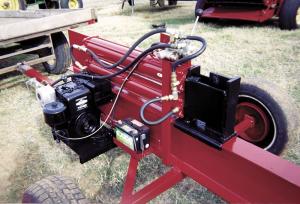2002 - Volume #26, Issue #1, Page #11
[ Sample Stories From This Issue | List of All Stories In This Issue | Print this story
| Read this issue]
Two Cylinders Give Home-Built Log Splitter Double The Power
 |
 |
While the stove keeps the 35 by 75 ft. shop comfortable, it takes a lot of wood and that, says Throener, means a lot of wood splitting.
"I built the stove to handle big chunks of wood but then discovered that most log splitters wouldn't handle anything bigger than 10 in. in diameter," he says.
So he built a heavy duty trailer-mounted splitter that will handle just about any size and any kind of wood he can put into it.
He started with a 12 in. I-beam that serves as a base for the splitter. The I-beam mounts on an axle made from a length of 2 by 1/4-in. square tubing. On this, he mounted a pair of wheels salvaged off an old trailer built from the front spindles and hub of a car. On the front, he added another length of square tubing and a ball hitch.
A key feature of the splitter is a ram powered by twin hydraulic cylinders, which forces wood chunks through a stationary wedge. The splitter has self-contained hydraulics, powered by an 11 hp gas engine.
"I had an old engine I was going use to make a generator, but never got around to it. I figured this would be a good use for it," he says. He bought a new hydraulic pump, hoses and fittings, but everything else he used for the splitter came from salvage yards.
To assure that the twin hydraulic cylinders worked together and not against each other, he plumbed them with a T fitting off the main hydraulic line. He mounted the two 4-in. cylinders parallel in a horizontal position in the splitter. He unscrewed the clevis fasteners from the ends of the shafts and threaded them into holes precisely located in a 12 by 4-in. piece of 1-in. plate steel to make the ram for the splitter.
"The two 4 in. cylinders together give me the same power as an 8 in. cylinder, which would have been considerably more expensive," he says.
To make the wedge for his splitter, he started with another 1-ft. square of 1-in. plate steel. He sharpened one side of the square, beveling it back about 60-degrees. On both sides of this plate, halfway back from the sharp edge, he welded two more 1-in. thick pieces of plate steel, measuring 6 by 12 in. He beveled the leading edge of each to about 45 degrees. This makes the back edge of the wedge 3 in. thick. "It does a good job with most wood," he says. "I could add a third layer of plate at the back of the wedge to make it split even faster."
Throener says it will split wood larger than he can easily lift into it. "I'd like to add a hydraulic lift to be able to pick up larger pieces for splitting," he says.
Contact: FARM SHOW Followup, Matt Throener, Matt's Ag Service, Rt. 2, Box 55, Carnegie, Okla. 73015 (ph 580 654-1212; fax 580 654-2117).

Click here to download page story appeared in.

Click here to read entire issue
To read the rest of this story, download this issue below or click here to register with your account number.




